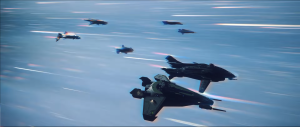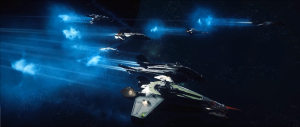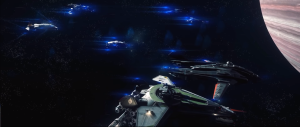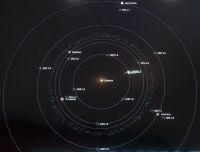量子驅動器是一種基於量子介質操縱的發動機類型,它允許船舶在合理的時間內穿越廣闊的開放宇宙空間。
How it works

量子驅動器在飛船周圍產生一個氣泡,其作用是用來收縮正前方的空間並同時擴大正後方的空間,本質上來說就是一個阿爾庫別瑞引擎。該過程設計操縱船舶周圍的能量密度。由於這一操作會收縮和擴大你周圍的空間,因此參照物係數保持不變,這就意味著氣泡內任何物體都不會受到加速的影響。[1]
Quantum fuel (which is refined from quantanium) is the fuel source used to create the required negative energy density around the ship. A large amount of power is required to convert Quantum Matter into a negative energy field. Such a field generates a significant amount of heat. The continued operation of the drive creates more heat than almost all ships have the ability to absorb, but the larger the ship, the greater capacity for both power generation and cooling, so the heat doesn't build up as quickly as it would on a smaller ship.[1]
Limitations
Currently, ships in quantum can travel at speeds up to 0.2c, or 20% of the speed of light [2], when travelling long distance. Shorter journeys do not approach 0.2c. The speed of travel also varies significantly by the specific quantum drive installed, primarily based on its size. For instance, an S3 Drive (commonly found on capital ships) is capable of approximately twice the speed of an S1 Drive (commonly found on single seat ships).
Larger ship have an advantage since there is more space for power generators and cooling units. The Idris is a good example with its huge reactor room and its cooling bath. It takes longer for a large ship to reach the point where it must shut down to allow it too cool down. This is why larger ships can Quantum travel for a longer duration when compared to a smaller ship that can't dedicate nearly as much space to power generation and cooling. This is also the reason very small ships like a Merlin don't have a Quantum Drive at all: they simply lack the room for the minimum power and cooling needed for a Quantum Drive.[1]

Long jumps, particularly with smaller quantum drives, can result in overheating, causing the ship to fall out of quantum. This can be avoided by either turning off excess power drains, such as weaponry, or by overclocking the quantum drive or coolers. There is also a cooldown time after using the drive.
Quantum travel requires spooling of the drive. Spool time varies by anticipated travel distance. The player must also wait for the quantum drive to be calibrated for the selected destination before being able to activate it. Certain actions can prevent another ship from spooling as a means of stopping prey from escaping, such as EMP. Calibration can also sometimes be hindered by an obstruction between the ship and target destination, such as another ship or an asteroid. However this doesn't apply to 'splined' quantum jumps, which curve around the nearby system body.
Interdiction is the act of 'pulling' another ship out of quantum, an ambush tactic used for both tactical engagement and piracy. NPCs are capable of interdicting players, which spawns an asteroid cluster providing a playing field for the ambush to take place on, rather than simply being open space as would almost definitely be the case without this spawning mechanic.
Jump drives
Quantum drives are capable of being "upgraded" with Jump Drives to allow for the usage of Jump points.
Quantum Enforcement
Users of quantum drives should be aware of quantum enforcement techniques, used to stall or deactivate quantum drives. Quantum Enforcement Devices (QEDs) can either produce a Quantum Snare to pull ships out of an active quantum route, or Quantum Dampening to prevent the activation and spooling of quantum drives
Quantum linking

Quantum drives are also capable of linking together and performing a group jump. By synchronizing a group of ships, a 'Jump Leader' can select a destination, and after waiting for all of the ships to calibrate, can direct the group of ships to jump automatically to the destination. This simplifies group travel and makes it easier for fleets to coordinate jumps.
Quantum destinations
Quantum travel requires a target destination, and these come in five forms:
Bodies
System bodies such as planets, moons and asteroids.
Lagrangian points

Lagrangian points in this context are locations in space relative to a planet where the planet's gravitational effects are nullified. I.E. in real life, an object at this location will remain in place relative to the planet. A planet has five lagrangian points, and in Star Citizen these locations are typically (but not always) home to Rest Stops.
L1 is located towards the system's gravitational center (e.g., its star) from the planet. L2 is towards the system's edge from the planet, and further away than L1. L3 is on the same orbit as the planet but directly opposite the planet's position. L4 and L5 are also on the same orbit but slightly lead or follow the planet and each form equilateral triangles with the planet and the gravitational center. Together, L3, L4, and L5 generally ensure that a quantum travel destination is always visible from any location in the system.
Orbital marker (OM)
Planets and moons each typically have six orbital markers in a high orbit far from the atmosphere. OM-1 is above the North Pole and OM-2 is above the South Pole. the other four are equidistant around the equator. OMs can be used to quickly move around the planet to reach line-of-sight with a previously obstructed destination target or to get closer to an unmarked planetside location.
Geodesic marker (GM)
GMs allow quantum travel to the upper atmosphere of planets and moons for speedy access to the surface. These typically correspond to a settlement or landmark on the ground. Dedicated "landing zones" have a unique marker to distinguish them from other less significant landmarks.
Quantum beacon
This is a deployable satellite that broadcasts a quantum destination marker. They are typically encountered in missions and can be turned off to prevent others from arriving via quantum travel.
History
On May 3, 2075, the first self-sustaining quantum drive engine was completed by Dr. Scott Childress along with a team from 羅伯茨太空工業. The device was called the Quantum Core Engine. It was capable of space travel at 1% of the speed of light. Overnight, the space travel industry was born and spaceflight for civilians became possible.[3][4]
In 2214, 羅伯茨太空工業 released its Poseidon fusion engine, pushing the new speed limit of space travel to 10% of the speed of light, or 18,600 miles per second.[5]
References
- ↑ 1.0 1.1 1.2 Chris Roberts on Quantum Drives. Retrieved 2020-03-21
- ↑
- ↑ Comm-Link:2075 - The Stars Get A Little Closer. 通訊連結
- ↑ Robert Space Industries (RSI). 銀河百科. Retrieved 2020-03-21
- ↑ Comm-Link:2214 - The March of Progress. 通訊連結


